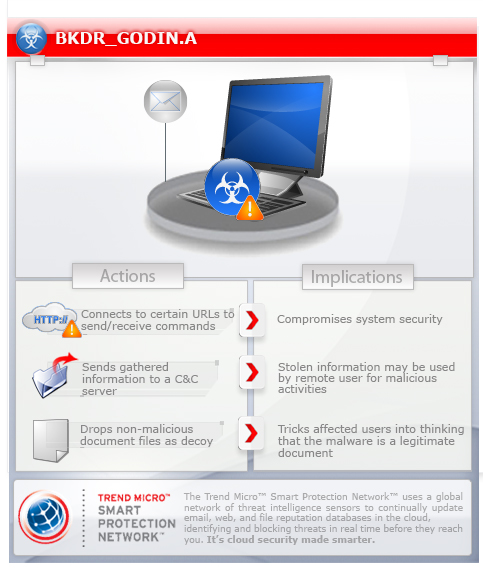BKDR_GODIN.A
Trojan:Win32/Godin.A (Microsoft), Trojan Horse (Symantec), Generic.grp!lw (McAfee)
Windows 2000, Windows Server 2003, Windows XP (32-bit, 64-bit), Windows Vista (32-bit, 64-bit), Windows 7 (32-bit, 64-bit)


Threat Type: Backdoor
Destructiveness: No
Encrypted: No
In the wild: Yes
OVERVIEW
This malware is involved in certain targeted attacks that took place on March 2013. It drops and opens non-malicious document files to hide its backdoor routines. Users affected by this malware may find the security of their systems compromised.
To get a one-glance comprehensive view of the behavior of this Backdoor, refer to the Threat Diagram shown below.

This backdoor arrives as an attachment to email messages spammed by other malware/grayware or malicious users.
It runs certain commands that it receives remotely from a malicious user. Doing this puts the affected computer and information found on the computer at greater risk. However, as of this writing, the said sites are inaccessible.
TECHNICAL DETAILS
Arrival Details
This backdoor arrives as an attachment to email messages spammed by other malware/grayware or malicious users.
Installation
This backdoor drops the following files:
- %User Temp%\ctfmon.exe - also detected as BKDR_GODIN.A
(Note: %User Temp% is the current user's Temp folder, which is usually C:\Documents and Settings\{user name}\Local Settings\Temp on Windows 2000, XP, and Server 2003, or C:\Users\{user name}\AppData\Local\Temp on Windows Vista and 7.)
It drops the following non-malicious files:
- %User Temp%\Investment of Intermediate Range Ballistic Missile Targets.pdf
- %User Temp%\Lanl_Office_Contact_oct.pdf
- %User Temp%\US hesitant in condemning North Korean launch.pdf
(Note: %User Temp% is the current user's Temp folder, which is usually C:\Documents and Settings\{user name}\Local Settings\Temp on Windows 2000, XP, and Server 2003, or C:\Users\{user name}\AppData\Local\Temp on Windows Vista and 7.)
It drops the following copies of itself into the affected system:
- %User Profile%\Local Settings\ctfmon.exe
(Note: %User Profile% is the current user's profile folder, which is usually C:\Documents and Settings\{user name} on Windows 2000, XP, and Server 2003, or C:\Users\{user name} on Windows Vista and 7.)
It adds the following mutexes to ensure that only one of its copies runs at any one time:
- CTFMON
- SYMTEC*&^@()!!!*!@&
Autostart Technique
This backdoor adds the following registry entries to enable its automatic execution at every system startup:
HKEY_CURRENT_USER\Software\Microsoft\
Windows\CurrentVersion\Run
Symantec Update = "%User Profile%\Local Settings\ctfmon.exe"
It drops the following file(s) in the Windows User Startup folder to enable its automatic execution at every system startup:
- ctfmon.exe
Backdoor Routine
This backdoor executes the following command(s) from a remote malicious user:
- Download and execute arbitrary files
- Sleep
It connects to the following URL(s) to send and receive commands from a remote malicious user:
- http://{BLOCKED}aks.{BLOCKED}s.us/info/2013.html?{time stamp}
- http://{BLOCKED}i.{BLOCKED}s.info/office/1239.html?{time stamp}
- http://{BLOCKED}ansystems.{BLOCKED}s.info/office/1282.html?{time stamp}
- http://{BLOCKED}s.{BLOCKED}a.sh/news_files/infon.html?{time stamp}
- http://{BLOCKED}ech.{BLOCKED}s.info/office/1243.html?{time stamp}
- http://{BLOCKED}a.{BLOCKED}l.nf/corporate/fbo.html?{time stamp}
- http://{BLOCKED}aip.{BLOCKED}s.info/office/8122.html?{time stamp}
- http://{BLOCKED}e.{BLOCKED}s.info/office/1345.html?{time stamp}
- http://{BLOCKED}ng.{BLOCKED}s.info/office/2395.html?{time stamp}
- http://{BLOCKED}a.{BLOCKED}l.nf/corporate/fbo.html?{time stamp}
It posts the following information to its command and control (C&C) server:
- Computer Name
- IP Address
- Time of Infection
However, as of this writing, the said sites are inaccessible.
Other Details
This backdoor opens the following files:
- %User Temp%\Investment of Intermediate Range Ballistic Missile Targets.pdf
- %User Temp%\Lanl_Office_Contact_oct.pdf
- %User Temp%\US hesitant in condemning North Korean launch.pdf
(Note: %User Temp% is the current user's Temp folder, which is usually C:\Documents and Settings\{user name}\Local Settings\Temp on Windows 2000, XP, and Server 2003, or C:\Users\{user name}\AppData\Local\Temp on Windows Vista and 7.)
NOTES:
The file path and name used for the downloaded file from the backdoor routine can be any of the following:
- %User Profile%\Local Settings\setup.exe
- %Windows%\setup.exe
- %Windows%\FXSST.DLL
It only uses either one of the items stated above for the following routines depending on the sample that arrived in your system:
- Mutex
- Autostart techniques
- URLs accessed
- Dropped non-malicious files
SOLUTION
Step 1
Before doing any scans, Windows XP, Windows Vista, and Windows 7 users must disable System Restore to allow full scanning of their computers.
Step 2
Terminate a process file/s detected as BKDR_GODIN.A
*Note: If the detected file/s is/are not displayed in theWindows Task Manager, continue doing the next steps.
Step 3
Delete this registry value
Important: Editing the Windows Registry incorrectly can lead to irreversible system malfunction. Please do this step only if you know how or you can ask assistance from your system administrator. Else, check this Microsoft article first before modifying your computer's registry.
- In HKEY_CURRENT_USER\Software\Microsoft\Windows\CurrentVersion\Run
- Symantec Update = "%User Profile%\Local Settings\ctfmon.exe"
- Symantec Update = "%User Profile%\Local Settings\ctfmon.exe"
Step 4
Search and delete these files
- %User Temp%\Investment of Intermediate Range Ballistic Missile Targets.pdf
- %User Temp%\Lanl_Office_Contact_oct.pdf
- %User Temp%\US hesitant in condemning North Korean launch.pdf
- %User Profile%\Local Settings\setup.exe
- %Windows%\setup.exe
- %Windows%\FXSST.DLL
Step 5
Scan your computer with your Trend Micro product to delete files detected as BKDR_GODIN.A. If the detected files have already been cleaned, deleted, or quarantined by your Trend Micro product, no further step is required. You may opt to simply delete the quarantined files. Please check this Knowledge Base page for more information.
Did this description help? Tell us how we did.

